
Photo
Browse an alphabetical list of photographs. These historical images portray people, places, and events before, during, and after World War II and the Holocaust.
<< Previous | Displaying results 1-50 of 69 for "Photo" | Next >>
-
ID Card for a Jewish DP camp resident
PhotoThis identification card was issued to Sima Wajner, a Jewish resident of the Heidenheim displaced persons camp. The card identifies her as a former concentration camp inmate who had been imprisoned in the Stuffhof camp during the Holocaust. Card dated January 23, 1947.
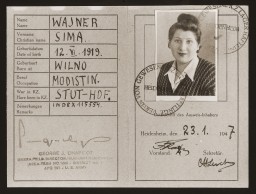
-
Identification card issued to Oskar Russ in the Feldafing displaced persons' camp
PhotoIdentification card issued to Oskar Russ in the Feldafing displaced persons' camp. Oskar Russ was born in Poland in 1907. During the Holocaust, he was imprisoned in the Dachau concentration camp. After liberation, he was in the Feldafing displaced persons camp before immigrating in 1947 to the United States with his wife (whom he had married in Feldafing).
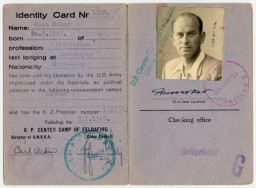
-
Identification card of Berthe Levy Cahen
PhotoIdentification card of Berthe Levy Cahen, issued by the French police in Lyon, stamped "Juif" ("Jew"). France, August 7, 1942.

-
Identification photos of a man arrested for homosexuality
PhotoIdentification pictures of a bartender from Duisburg who was arrested under Paragraph 175. Duisburg, Germany, August 27, 1936.

-
Identification photos of a prisoner accused of homosexuality
PhotoIdentification pictures of a prisoner, accused of homosexuality, recently arrived at the Auschwitz camp. Auschwitz, Poland, between 1940 and 1945.
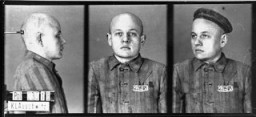
-
Identification photos of prisoner accused of homosexuality
PhotoIdentification pictures of a prisoner, accused of homosexuality, who arrived at the Auschwitz camp on June 6, 1941. He died there a year later. Auschwitz, Poland.

-
Identification picture of a prisoner accused of homosexuality
PhotoIdentification picture of a prisoner, accused of homosexuality, who arrived at the Auschwitz camp on May 28, 1941. Auschwitz, Poland.
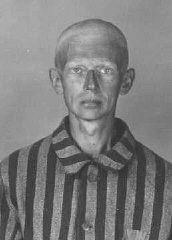
-
Illustrated page of a child's diary written in a Swiss refugee camp
PhotoIllustrated page of a child's diary written in a Swiss refugee camp. The diary entry describes how they crossed the border into Switzerland. The text reads, "We came out of the woods and into a clearing: we had to be as quiet as possible because we were so close to the border. Oh! I almost forgot! Before we came out of the woods, they made us stand still for a quarter of an hour while they went to explore the area and to cut through the fence. Fortunately, shortly thereafter, we began to walk again. We saw…
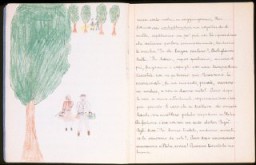
-
Illustration from an antisemitic children's book
PhotoIllustration from an antisemitic children's book. The sign reads "Jews are not wanted here." Books such as this one used antisemitic caricatures in an attempt to promote Nazi racial ideology. Germany, 1936.
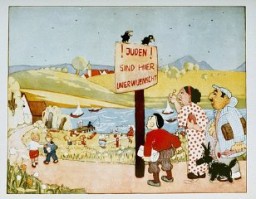
-
Illustration from an antisemitic German children's book
PhotoIllustration from an antisemitic German children's book, Der Giftpilz (The Poisonous Mushroom), used to indoctrinate children in the Nazi worldview. It was published in Nuremberg, Germany, in 1935. The caption to the image on the page shown here reads: "The Jewish nose is crooked, it looks like a 6."

-
Im Fout labor camp
PhotoAn unidentified worker walks by the railroad tracks at the Im Fout labor camp in Morocco. Living conditions were harsh in the camp, and many of the workers fell ill with typhus. Im Fout, Morocco, 1941-42.
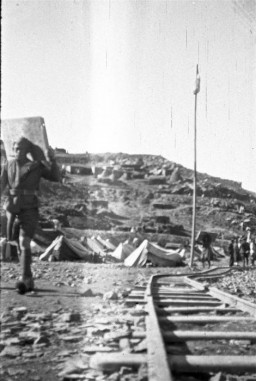
-
Images of a peaceful Germany
PhotoAn American travel agency displays images of a peaceful Germany sent by the German Railways Information Office to attract visitors to the 1936 Olympic Games in Berlin. United States, prewar.

-
In Front of the Stuttgart West Displaced Persons Camp
PhotoHenry Brauner (center) with his wife, Esther (second from right), pose with three friends in front of the entrance to the Stuttgart West displaced persons (DP) camp, 1945.

-
Incarcerated for homosexuality
PhotoAn official order incarcerating the accused in the Sachsenhausen concentration camp for the "offence" of homosexuality. Germany, July 1944. The Nazis posed as moral crusaders who wanted to stamp out what they labeled as the "vice" of homosexuality in order to help Germany win the racial struggle. They persecuted homosexuals as part of their so-called moral crusade to racially and culturally purify Germany.

-
Indictment of the IG Farben defendants
PhotoThe IG Farben defendants hear the indictments against them before the start of the trial, case #6 of the Subsequent Nuremberg Proceedings. May 5, 1947.
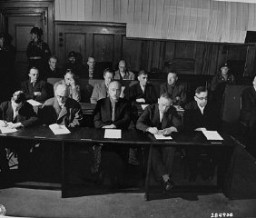
-
Informal family portrait
PhotoBlanka and Harry with their daughter Shelly, son-in-law, and granddaughter Alexis Danielle. San Diego, California.
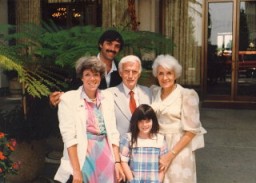
-
Inge Viermetz pleads not guilty
PhotoDefendant Inge Viermetz pleads not guilty at her arraignment during the RuSHA Trial, case #8 of the Subsequent Nuremberg Proceedings. October 10, 1947.

-
Ink and Blood by Arthur Szyk, 1944
PhotoInk and Blood by Arthur Szyk, 1944. Szyk portrayed himself at his desk, finishing off a still-struggling Adolf Hitler. Göring, Himmler, and Franco attempt to escape. In the wastebasket are the defeated figures of Mussolini, Laval, and Petain, whose regimes fell as a result of the Allied invasions. [Gift of Alexandra and Joseph Braciejowski]
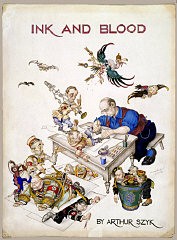
-
Insignia of the 101st Airborne Division
PhotoInsignia of the 101st Airborne Division. The nickname of the 101st Airborne Division, "Screaming Eagles," originates from the division's insignia, a bald eagle on a black shield. "Old Abe" was the eagle mascot of a Wisconsin regiment during the Civil War. The 101st was formed as a reserve unit in Wisconsin shortly after World War I and included "Old Abe" as part of the division's insignia.
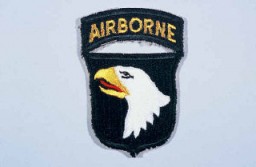
-
Insignia of the 103rd Infantry Division
PhotoInsignia of the 103rd Infantry Division. The 103rd Infantry Division, the "Cactus" division, is so called after the 103rd's shoulder patch, a cactus in a gold circle. The cactus is representative of the states whose troops formed the unit in the early 1920s: Arizona, Colorado, and New Mexico.
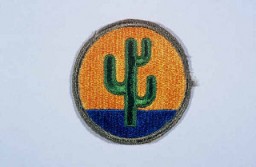
-
Insignia of the 104th Infantry Division
PhotoInsignia of the 104th Infantry Division. The nickname of the 104th Infantry Division, "Timberwolf," originated from the division's insignia, a gray timberwolf. The timberwolf, native to the Pacific Northwest, was chosen as representative of the area where the division was formed in 1942.
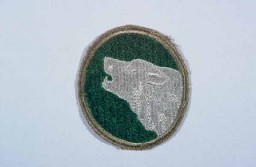
-
Insignia of the 10th Armored Division
PhotoInsignia of the 10th Armored Division. The "Tiger Division" nickname of the 10th originates from a division-wide contest held while it was training in the United States, symbolizing the division "clawing and mauling" its way through the enemy.
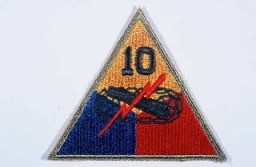
-
Insignia of the 11th Armored Division
PhotoInsignia of the 11th Armored Division. "Thunderbolt" is a nickname adopted by the 11th Armored Division during its rapid march in December 1944 to reinforce US troops defending against the German military offensive in the Ardennes Forest.
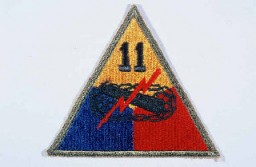
-
Insignia of the 12th Armored Division
PhotoInsignia of the 12th Armored Division. "Hellcats, " the winning entry in a division contest for a nickname held in early in 1943, symbolized the 12th's toughness and readiness for combat.
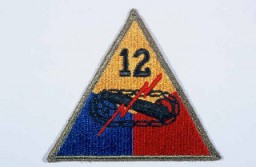
-
Insignia of the 14th Armored Division
PhotoInsignia of the 14th Armored Division. Although lacking a nickname during the war, the 14th became known as the "Liberators" soon afterward to signify its accomplishments in liberating hundreds of thousands of forced and slave laborers, concentration camp prisoners, and Allied prisoners of war in 1945.
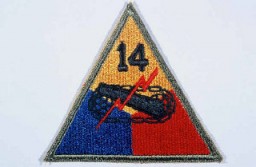
-
Insignia of the 1st Infantry Division
PhotoInsignia of the 1st Infantry Division. The 1st Infantry Division's nickname, the "Big Red One," originated from the division's insignia, a large red number "1" on a khaki field. This nickname was adopted during World War I, when the 1st was the first American division to arrive in France.
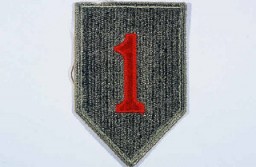
-
Insignia of the 20th Armored Division
PhotoInsignia of the 20th Armored Division. Although no nickname is commonly associated with the 20th, "Armoraiders" may have been occasionally in use during World War II.
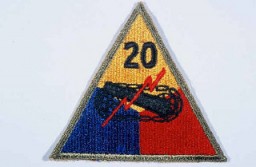
-
Insignia of the 26th Infantry Division
PhotoInsignia of the 26th Infantry Division. The 26th Infantry Division, the "Yankee" division, was so nicknamed to recognize the six New England states from whose National Guard units the division was raised during World War I.
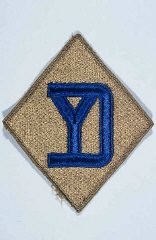
-
Insignia of the 29th Infantry Division
PhotoInsignia of the 29th Infantry Division. "Blue and Gray" was coined as the nickname of the 29th Infantry Division by the division's commander during World War I. The name commemorates the lineage of the mid-Atlantic states' National Guard units that formed the division, many with service on both sides during the Civil War.
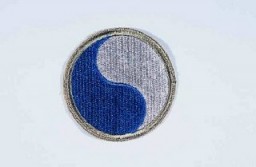
-
Insignia of the 2nd Infantry Division
PhotoInsignia of the 2nd Infantry Division. The nickname of the 2nd Infantry Division, "Indianhead," was derived from its World War I insignia. This insignia was developed from an emblem a truck driver in the division had painted on his truck.

-
Insignia of the 30th Infantry Division.
PhotoInsignia of the 30th Infantry Division. The nickname of the 30th Division was Old Hickory, named after President Andrew Jackson.
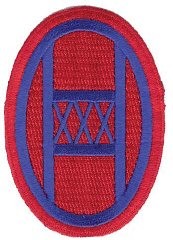
-
Insignia of the 36th Infantry Division
PhotoInsignia of the 36th Infantry Division. The 36th Infantry Division, the "Texas" division, was raised from National Guard units from Texas and Oklahoma during World War I. The "T" in the division's insignia represents Texas, the arrowhead Oklahoma. The division was also sometimes called the "Lone Star" division, again symbolizing its Texas roots.
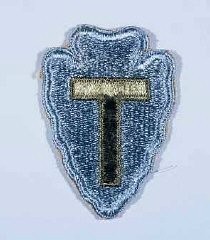
-
Insignia of the 3rd Armored Division
PhotoInsignia of the 3rd Armored Division. "Spearhead" was adopted as the nickname of the 3rd Armored Division in recognition of the division's role as the "spearhead" of many attacks during the liberation of France in 1944.

-
Insignia of the 42nd Infantry Division
PhotoInsignia of the 42nd Infantry Division. The nickname of the 42nd Infantry Division, the "Rainbow" division, reflects the composition of the division during World War I. The division was drawn from the National Guards of 26 states and the District of Columbia. It represented a cross section of the American people, as the rainbow represents a cross section of colors.

-
Insignia of the 45th Infantry Division
PhotoInsignia of the 45th Infantry Division. The 45th Infantry Division gained its nickname, "Thunderbird" division, from the gold thunderbird. This Native American symbol became the division's insignia in 1939. It replaced another previously used Native American symbol, a swastika, that was withdrawn when it became closely associated with the Nazi Party.
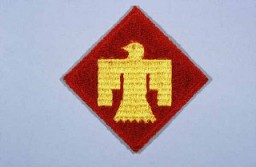
-
Insignia of the 4th Armored Division
PhotoInsignia of the 4th Armored Division. The commanding general of the 4th Armored Division refused to sanction an official nickname for the 4th, believing that the division's accomplishments on the battlefield made one unnecessary. "Breakthrough" was occasionally used, apparently to highlight the division's prominent role in the breakout from the Normandy beachhead and liberation of France in 1944.
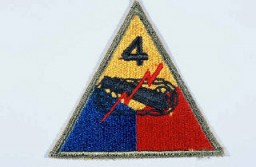
-
Insignia of the 4th Infantry Division
PhotoInsignia of the 4th Infantry Division. The 4th Infantry Division's nickname, the "Ivy" division, is derived from the divisional insignia developed during World War I: four ivy leaves on a diamond field, symbolizing the roman numeral "IV."

-
Insignia of the 63rd Infantry Division
PhotoInsignia of the 63rd Infantry Division. The 63rd Infantry Division was nicknamed the "Blood and Fire" division soon after its formation in the spring of 1943. The nickname commemorates British prime minister Winston Churchill's statement at the Casablanca Conference in January 1943 that "the enemy would bleed and burn in expiation of their crimes against humanity." The divisional insignia illustrates the nickname.
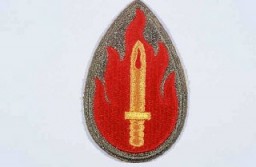
-
Insignia of the 65th Infantry Division
PhotoInsignia of the 65th Infantry Division. The 65th Infantry Division was nicknamed the "Battle Axe" after the divisional insignia, a halbert (an axe on a pole), used to cut through the enemy during medieval times.

-
Insignia of the 69th Infantry Division
PhotoInsignia of the 69th Infantry Division. The 69th Infantry Division gained the nickname the "Fighting 69th" during World War II. The name has no heraldic significance, but simply conveys the esprit de corps of the division.
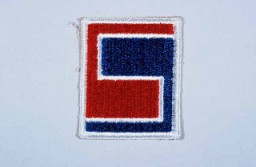
-
Insignia of the 6th Armored Division
PhotoInsignia of the 6th Armored Division. "Super Sixth" became the nickname of the 6th Armored Division while the division was training in the United States, apparently to symbolize the division's spirit.
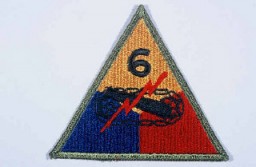
-
Insignia of the 71st Infantry Division
PhotoInsignia of the 71st Infantry Division. The nickname of the 71st Infantry Division, the "Red Circle" division, is based upon the divisional insignia (which includes a red circle).
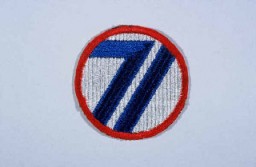
-
Insignia of the 80th Infantry Division
PhotoInsignia of the 80th Infantry Division. The nickname of the 80th Infantry Division, the "Blue Ridge" division, reflects the home states of the majority of soldiers who formed the division during World War I: Pennsylvania, West Virginia, and Virginia. The Blue Ridge Mountains run through these three states.
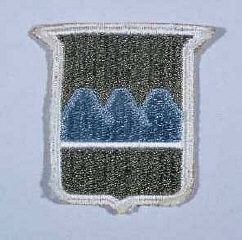
-
Insignia of the 82nd Airborne Division
PhotoInsignia of the 82nd Airborne Division. The nickname for the 82nd Airborne Division originated in World War I, signifying the "All American" composition of its members. The troops who formed the division came from diverse areas of the United States.
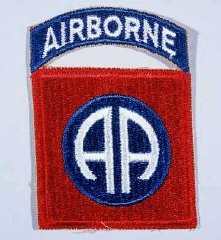
-
Insignia of the 83rd Infantry Division
PhotoInsignia of the 83rd Infantry Division. The 83rd Infantry Division received its nickname, the "Thunderbolt" division, after a division-wide contest for a new nickname held in early 1945. The earlier nickname, "Ohio," was based on the division's insignia (which includes the name "Ohio," where the division was raised during World War I). A new nickname was desired to represent the nationwide origins of the division's personnel during World War II.
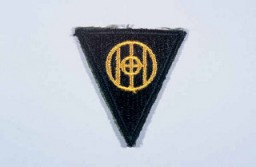
-
Insignia of the 84th Infantry Division
PhotoInsignia of the 84th Infantry Division. The 84th Infantry Division derives its nickname, "Railsplitter" division, from the divisional insignia, an ax splitting a rail. This design was created during World War I, when the division was known as the "Lincoln" division to represent the states that supplied soldiers for the division: Illinois, Indiana, and Kentucky. All figured prominently in the life of President Abraham Lincoln, of log-splitting legend.
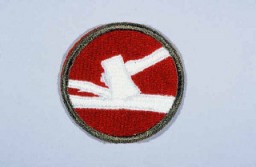
-
Insignia of the 86th Infantry Division
PhotoInsignia of the 86th Infantry Division. The 86th Infantry Division developed the blackhawk as its insignia during World War I, to honor the Native American warrior of that name who fought the US Army in Illinois and Wisconsin during the early nineteenth century. The nickname "The Blackhawks" or "Blackhawk" division is derived from the insignia.
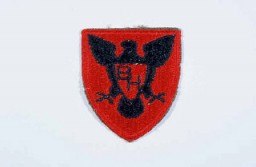
-
Insignia of the 89th Infantry Division
PhotoInsignia of the 89th Infantry Division. The 89th Infantry Division's nickname, the "Rolling W," is based on the division's insignia. Created during World War I, this insignia utilized a letter "M" inside a wheel. When the wheel turns, the "M" becomes a "W." The letters "MW" signify the mid-west origin of the troops who formed the 89th during World War I. The division was also known as the "Middle West" division, another variation on its origin.

-
Insignia of the 8th Armored Division
PhotoInsignia of the 8th Armored Division. The nickname of the 8th Armored Division, the "Thundering Herd," was coined before the division went to Europe in late 1944. It was also known as the "Iron Snake" late in the war, after a correspondent for Newsweek likened the 8th to a "great ironclad snake" as it crossed the Rhine River in late March 1945.
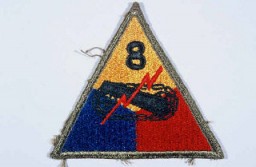
-
Insignia of the 8th Infantry Division
PhotoInsignia of the 8th Infantry Division. The 8th Infantry Division was known as both the "Golden Arrow" and "Pathfinder" division during World War II. Both nicknames originated from the division's insignia, which includes a gold arrow to represent the nineteenth century explorer of California, John Fremont. The division was formed in California in 1918.
